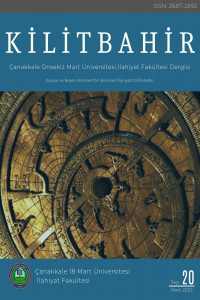Din, Maneviyat ve Diğerkâmlık*
-
-
-,
___
- Ahmed, A. M. (2009). Are religious people more prosocial? A quasi- experimental study with Madrasah pupils in a rural community in India. Journal for the Scientific Study of Religion, 48, 368–374. doi:10.1111/ j.1468-5906.2009.01452.x
- Ahmed, A. M., & Salas, O. (2011). Implicit influences of Christian religious representations on dictator and prisoner’s dilemma game decisions. Journal of Socio- Economics, 40, 242–246. doi:10.1016/j. socec.2010.12.013
- Anderson, L. R., & Mellor, J. M. (2009). Religion and cooperation in a public goods experiment. Economics Letters, 105, 58–60. doi:10.1016/j.econlet. 2009.05.016
- Aquino, K., Freeman, D., Reed, A., Lim, V. K. G., & Felps, W. (2009). Testing a social-cognitive model of moral behavior: The interactive influence of situations and moral identity centrality. Journal of Personality and Social Psychology, 97, 123–141. doi:10.1037/a0015406
- Arzheimer, K., & Carter, E. (2009). Christian religiosity and voting for West European radical right parties. West European Politics, 32, 985–1011. doi:10.1080/01402380903065058
- Bargh, J. A., Chen, M., & Burrows, L. (1996). Automaticity of social behavior: Direct effects of trait construct and stereotype activation on action. Journal of Personality and Social Psychology, 71, 230–244. doi:10.1037/0022- 3514.71.2.230
- Bartlett, M. Y., & DeSteno, D. (2006). Gratitude and prosocial behavior: Helping when it costs you. Psychological Science, 17, 319–325. doi:10.1111/ j.1467- 9280.2006.01705.x
- Batson, C. D. (1983). Sociobiology and the role of religion in promoting prosocial behavior. Journal of Personality and Social Psychology, 45, 1380–1385. doi:10.1037/0022-3514.45.6.1380
- Ellens, J. H. (Ed.). (2007). The destructive power of religion: Violence in Judaism, Christianity, and Islam. Westport, CT: Praeger.
- Relationships, 22, 629–651.
- doi:1177/0265407505056439
- Stark, R. (2001). Gods, rituals, and the moral order. Journal for the Scientific
- , 619– 636. doi:10.1111/0021-8294.00081
- Steffen, P. R., & Masters, K. S. (2005). Does compassion mediate the intrinsic religion–health relationship? Annals of Behavioral Medicine, 30, 217–224. doi:10.1207/s15324796abm3003_6
- Stephenson, M. T., Morgan, S. E., Roberts-Perez, S. D., Harrison, T., Afifi, W., & Long, S. D. (2008). The role of religiosity, religious norms, subjective norms, and bodily integrity in signing an organ donor card. Health Communication, 23, 436–447.
- Strabac, Z., & Listhaug, O. (2008). Anti-Muslim prejudice in Europe: A multilevel analysis of survey data from 30 countries. Social Science Research, 37, 268– 286. doi:10.1016/j.ssresearch.2007.02.004
- Stürmer, S., & Snyder, M. (Eds.). (2010). The psychology of prosocial behavior: Group processes, intergroup relations, and helping. Chichester, England: Wiley- Blackwell.
- Sundén, H. (1959). Religionen och rollerna [Religion and roles]. Stockholm, Sweden: Diakonistyrelsen. Tan, J. H. W., & Vogel, C. (2008). Religion and trust: An experimental study. Journal of Economic Psychology, 29, 832–848. doi:10.1016/j.joep.2008.03.002
- Tao, H. L., & Yeh, P. (2007). Religion as an investment: Comparing the contributions and volunteer frequency among Christians, Buddhists, and folk religionists. Southern Economic Journal, 73, 770–790.
- Turiel, E. (2006). The development of morality. In W. Damon & R. M. Lerner (Series Eds.) & N. Eisenberg (Vol. Ed.), Handbook of child psychology: Vol. 3. Social, emotional, and personality development (6th ed., pp. 789–857). Hoboken, NJ: Wiley.
- Underwood, L. G. (2002). The human experience of compassionate love: Conceptual mapping and data from selected studies. In S. Post, L. G. Underwood, J. P. Schloss, & W. B. Hurlbut (Eds.), Altruism and altruistic love: Science, philosophy and religion in dialogue (pp. 72–88). New York, NY: Oxford University Press. doi:10.1093/acprof:oso/9780195143584.003.0009
- Van Cappellen, P., Corneille, O., Cols, S., & Saroglou, V. (2011). Beyond mere compliance to authoritative figures: Religious priming increases conformity to informational influence among submissive people. The International Journal for the Psychology of Religion, 21, 97–105.
- Van Cappellen, P., & Saroglou, V. (2010, June). Induction of positive emotions leads to spirituality through changes in basic beliefs: An experimental study. Paper presented at the 5th European Conference on Positive Psychology, Copenhagen, Denmark.
- Van Cappellen, P., & Saroglou, V. (2011). Awe activates religious and spiritual feelings and behavioral intentions. Psychology of Religion and Spirituality. Advance online publication. doi:10.1037/a0025986
- Van Pachterbeke, M., Freyer, C., & Saroglou, V. (2011). When authoritarianism meets religion: Sacrificing others in the name of abstract deontology. European Journal of Social Psychology, 41, 898–903. doi:10.1002/ejsp.834
- Veenvliet, S. G. (2008). Intrinsic religious orientation and religious teaching: Differential judgments toward same-gender sexual behavior and gay men and lesbians. The International Journal for the Psychology of Religion, 18, 53–65. doi:10.1080/10508610701719348
- Walker, L. J., Frimer, J. A., & Dunlop, W. L. (2010). Varieties of moral personality: Beyond the banality of heroism. Journal of Personality, 78, 907–942. doi:10.1111/j.1467-6494.2010.00637.x
- Weeden, J., Cohen, A. B., & Kenrick, D. T. (2008). Religious attendance as reproductive support. Evolution and Human Behavior, 29, 327–334. doi:10.1016/j.evolhumbehav.2008.03.004
- Whitley, B. E., Jr. (2009). Religiosity and attitudes toward lesbians and gay men: A meta-analysis. The International Journal for the Psychology of Religion, 19, 21–38. doi:10.1080/10508610802471104
- Wilhelm, M. O., Brown, E., Rooney, P. M., & Steinberg, R. (2008). The intergenerational transmission of generosity. Journal of Public Economics, 92, 2146– 2156. doi:10.1016/j.jpubeco.2008.04.004
- Williams, L. E., & Bargh, J. A. (2008). Experiences of physical warmth influence interpersonal warmth. Science, 322, 606–607. doi:10.1126/science.1162548
- Wiltermuth, S. S., & Heath, C. (2009). Synchrony and cooperation. Psychological Science, 20, 1–5. doi:10. 1111/j.1467-9280.2008.02253.x
- Wink, P., Ciciolla, L., Dillon, M., & Tracy, A. (2007). Religiousness, spiritual seeking, and personality: Findings from a longitudinal study. Journal of Personality, 75, 1051–1070. doi:10.1111/j.1467- 6494.2007.00466.x.
- Yayın Aralığı: Yılda 2 Sayı
- Başlangıç: 2012
- Yayıncı: Çanakkale Onsekiz Mart Üniversitesi
Din, Maneviyat ve Diğerkâmlık*
Cahiliye Dönemi Mekke Toplumunun Hz. Peygamber’in Nübüvvetine İlişkin İntibaları
İslam’ın Doğuşunda Toplumsal Realite
Mezheplerin Doğuşu ve İçtihat Tartışması
Abdurrahman el-Câmî’nin Risâle fi’l-vücûd Adlı Eserinin Tercüme, Tahlîl ve Tahkîki
Oruç ve Öfke Kontrolü Arasındaki İlişki Üzerine Bir Araştırma
